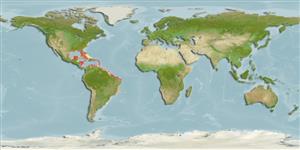Common names from other countries
Classification / Names / Names
Namen | Synonyme | Catalog of Fishes (gen., sp.) | ITIS | CoL | WoRMS
Environment: milieu / climate zone / depth range / distribution range
Ökologie
; tiefenbereich 6 - 20 m (Ref. 104365). Tropical
Western Atlantic: USA to Brazil.
Length at first maturity / Size / Gewicht / Alter
Maturity: Lm ? range ? - ? cmCommon length : 6.5 cm TL Männchen/unbestimmt; (Ref. 344)
Shell wedge-shaped, heavy, moderately inflated, with rhomboidal outline. Shell surface smooth. Posterodorsal slope somewhat flat. Pallial sinus large. Hinge with 2 lateral teeth (1 bifid) on each valve, lateral teeth absent. Umbones slightly posterior. Periostracum thin, glossy. Colour: tan cream with purple umbonal region; periostracum brown (Ref. 344).
It has a total length of 6.5 cm (Ref. 344). Combination depth range: min from literature, max from estimate. It is found infaunal in shallow sandy bottoms (Ref. 344). Infaunal (Ref. 104365).
Life cycle and mating behavior
Geschlechtsreife | Fortpflanzung | Ablaichen | Eier | Fecundity | Larven
Members of the class Bivalvia are mostly gonochoric, some are protandric hermaphrodites. Life cycle: Embryos develop into free-swimming trocophore larvae, succeeded by the bivalve veliger, resembling a miniature clam.
Leal, J.H. 2003. (Ref. 344)
IUCN Rote Liste Status (Ref. 130435)
CITES Status (Ref. 108899)
Not Evaluated
Not Evaluated
Nutzung durch Menschen
Fischereien: kommerziell
| FishSource |
Tools
Mehr Information
Alter/GrößeWachstumLänge-GewichtLänge-LängeMorphologieLarvenDichte
Internet Quellen
Estimates based on models
Preiskategorie
Unknown.
